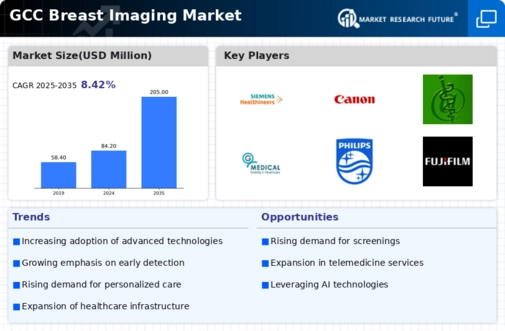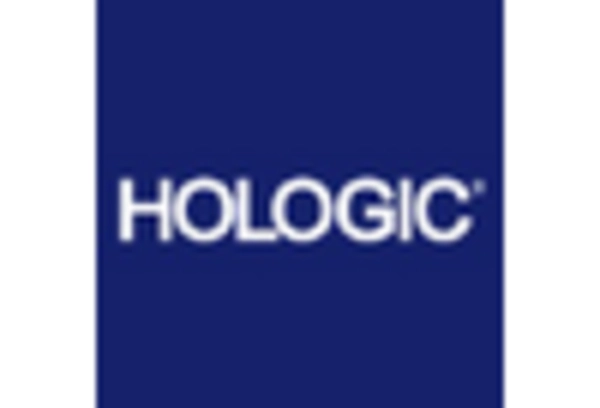Rising Awareness and Education
Rising awareness and education regarding breast health are crucial drivers for the breast imaging market. Campaigns aimed at educating women about the importance of regular screenings and early detection have gained momentum in the GCC. This increased awareness is likely to lead to higher screening rates, thereby boosting the demand for breast imaging services. The breast imaging market is expected to benefit from initiatives that promote breast cancer awareness, as they encourage women to seek timely diagnostic services. Furthermore, partnerships between healthcare providers and non-profit organizations are fostering community outreach programs that emphasize the significance of breast health. As more women become informed about their health, the likelihood of utilizing advanced imaging technologies for early detection increases, suggesting a positive outlook for the breast imaging market.
Increased Healthcare Investments
The GCC region is witnessing a surge in healthcare investments, which is significantly impacting the breast imaging market. Governments and private entities are channeling substantial funds into healthcare infrastructure, aiming to enhance diagnostic capabilities and patient care. For instance, the healthcare expenditure in the GCC is projected to reach approximately $100 billion by 2025, with a notable portion allocated to advanced imaging technologies. This influx of capital is likely to facilitate the procurement of modern breast imaging equipment, thereby improving access to essential screening services. The breast imaging market stands to benefit from these investments, as healthcare providers seek to upgrade their facilities and offer comprehensive diagnostic services. Additionally, the growing emphasis on preventive healthcare is expected to further drive the demand for breast imaging solutions, positioning the market for sustained growth in the coming years.
Regulatory Support and Standards
Regulatory support and the establishment of standards for breast imaging are vital factors influencing the market. In the GCC, health authorities are implementing guidelines to ensure the quality and safety of breast imaging services. These regulations are designed to standardize practices across healthcare facilities, thereby enhancing the reliability of diagnostic outcomes. The breast imaging market is likely to experience growth as compliance with these standards becomes mandatory, prompting healthcare providers to invest in accredited imaging technologies. Additionally, regulatory bodies are encouraging the adoption of best practices in breast cancer screening, which may lead to increased utilization of advanced imaging modalities. This supportive regulatory environment is expected to foster innovation and improve patient outcomes, ultimately contributing to the expansion of the breast imaging market.
Rising Incidence of Breast Cancer
The increasing incidence of breast cancer in the GCC region is a primary driver for the breast imaging market. According to health statistics, breast cancer accounts for approximately 30% of all cancer cases among women in the GCC. This alarming trend necessitates enhanced screening and diagnostic measures, thereby propelling the demand for advanced breast imaging technologies. As awareness about early detection grows, healthcare providers are investing in state-of-the-art imaging equipment, which is expected to boost market growth. The breast imaging market is likely to see a surge in demand for mammography, ultrasound, and MRI systems, as these modalities are crucial for effective diagnosis and treatment planning. Furthermore, the rising healthcare expenditure in the region supports the acquisition of advanced imaging technologies, indicating a robust growth trajectory for the breast imaging market.
Technological Innovations in Imaging
Technological innovations play a pivotal role in shaping the breast imaging market. The introduction of digital mammography, 3D tomosynthesis, and automated breast ultrasound systems has revolutionized the diagnostic landscape. These advancements enhance image quality, reduce radiation exposure, and improve detection rates, which are critical factors in the breast imaging market. For instance, 3D mammography has been shown to increase cancer detection rates by up to 40% compared to traditional methods. As healthcare facilities in the GCC adopt these cutting-edge technologies, the market is expected to expand significantly. Moreover, the integration of advanced imaging software and artificial intelligence tools further streamlines the diagnostic process, making it more efficient and accurate. This trend indicates a promising future for the breast imaging market, as continuous innovation drives the demand for sophisticated imaging solutions.

















Leave a Comment